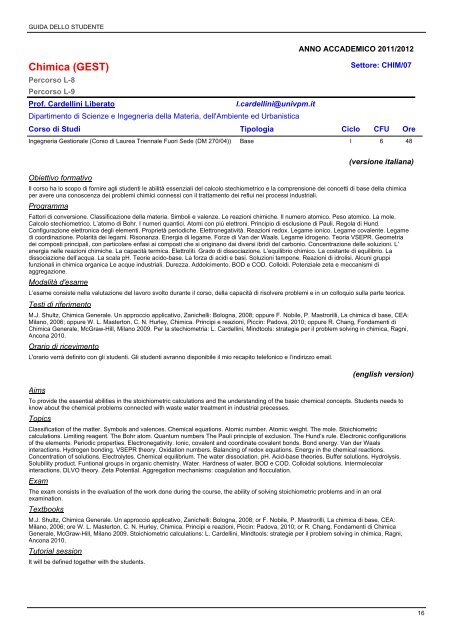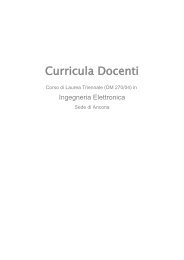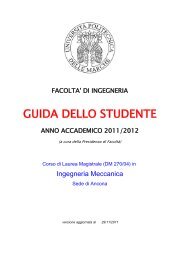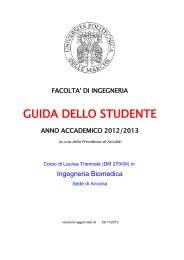guida - Facoltà di Ingegneria - Università Politecnica delle Marche
guida - Facoltà di Ingegneria - Università Politecnica delle Marche
guida - Facoltà di Ingegneria - Università Politecnica delle Marche
You also want an ePaper? Increase the reach of your titles
YUMPU automatically turns print PDFs into web optimized ePapers that Google loves.
GUIDA DELLO STUDENTE<br />
Chimica (GEST)<br />
Percorso L-8<br />
Percorso L-9<br />
Prof. Cardellini Liberato<br />
ANNO ACCADEMICO 2011/2012<br />
Settore: CHIM/07<br />
l.cardellini@univpm.it<br />
Dipartimento <strong>di</strong> Scienze e <strong>Ingegneria</strong> della Materia, dell'Ambiente ed Urbanistica<br />
Corso <strong>di</strong> Stu<strong>di</strong> Tipologia Ciclo CFU Ore<br />
<strong>Ingegneria</strong> Gestionale (Corso <strong>di</strong> Laurea Triennale Fuori Sede (DM 270/04)) Base I 6 48<br />
Obiettivo formativo<br />
(versione italiana)<br />
Il corso ha lo scopo <strong>di</strong> fornire agli studenti le abilità essenziali del calcolo stechiometrico e la comprensione dei concetti <strong>di</strong> base della chimica<br />
per avere una conoscenza dei problemi chimici connessi con il trattamento dei reflui nei processi industriali.<br />
Programma<br />
Fattori <strong>di</strong> conversione. Classificazione della materia. Simboli e valenze. Le reazioni chimiche. Il numero atomico. Peso atomico. La mole.<br />
Calcolo stechiometrico. L’atomo <strong>di</strong> Bohr. I numeri quantici. Atomi con più elettroni. Principio <strong>di</strong> esclusione <strong>di</strong> Pauli. Regola <strong>di</strong> Hund.<br />
Configurazione elettronica degli elementi. Proprietà perio<strong>di</strong>che. Elettronegatività. Reazioni redox. Legame ionico. Legame covalente. Legame<br />
<strong>di</strong> coor<strong>di</strong>nazione. Polarità dei legami. Risonanza. Energia <strong>di</strong> legame. Forze <strong>di</strong> Van der Waals. Legame idrogeno. Teoria VSEPR. Geometria<br />
dei composti principali, con particolare enfasi ai composti che si originano dai <strong>di</strong>versi ibri<strong>di</strong> del carbonio. Concentrazione <strong>delle</strong> soluzioni. L’<br />
energia nelle reazioni chimiche. La capacità termica. Elettroliti. Grado <strong>di</strong> <strong>di</strong>ssociazione. L’equilibrio chimico. La costante <strong>di</strong> equilibrio. La<br />
<strong>di</strong>ssociazione dell’acqua. La scala pH. Teorie acido-base. La forza <strong>di</strong> aci<strong>di</strong> e basi. Soluzioni tampone. Reazioni <strong>di</strong> idrolisi. Alcuni gruppi<br />
funzionali in chimica organica Le acque industriali. Durezza. Addolcimento. BOD e COD. Colloi<strong>di</strong>. Potenziale zeta e meccanismi <strong>di</strong><br />
aggregazione.<br />
Modalità d'esame<br />
L’esame consiste nella valutazione del lavoro svolto durante il corso, della capacità <strong>di</strong> risolvere problemi e in un colloquio sulla parte teorica.<br />
Testi <strong>di</strong> riferimento<br />
M.J. Shultz, Chimica Generale. Un approccio applicativo, Zanichelli: Bologna, 2008; oppure F. Nobile, P. Mastrorilli, La chimica <strong>di</strong> base, CEA:<br />
Milano, 2006; oppure W. L. Masterton, C. N. Hurley, Chimica. Principi e reazioni, Piccin: Padova, 2010; oppure R. Chang, Fondamenti <strong>di</strong><br />
Chimica Generale, McGraw-Hill, Milano 2009. Per la stechiometria: L. Cardellini, Mindtools: strategie per il problem solving in chimica, Ragni,<br />
Ancona 2010.<br />
Orario <strong>di</strong> ricevimento<br />
L'orario verrà definito con gli studenti. Gli studenti avranno <strong>di</strong>sponibile il mio recapito telefonico e l’in<strong>di</strong>rizzo email.<br />
Aims<br />
(english version)<br />
To provide the essential abilities in the stoichiometric calculations and the understan<strong>di</strong>ng of the basic chemical concepts. Students needs to<br />
know about the chemical problems connected with waste water treatment in industrial precesses.<br />
Topics<br />
Classification of the matter. Symbols and valences. Chemical equations. Atomic number. Atomic weight. The mole. Stoichiometric<br />
calculations. Limiting reagent. The Bohr atom. Quantum numbers The Pauli principle of exclusion. The Hund’s rule. Electronic configurations<br />
of the elements. Perio<strong>di</strong>c properties. Electronegativity. Ionic, covalent and coor<strong>di</strong>nate covalent bonds. Bond energy. Van der Waals<br />
interactions. Hydrogen bon<strong>di</strong>ng. VSEPR theory. Oxidation numbers. Balancing of redox equations. Energy in the chemical reactions.<br />
Concentration of solutions. Electrolytes. Chemical equilibrium. The water <strong>di</strong>ssociation. pH. Acid-base theories. Buffer solutions. Hydrolysis.<br />
Solubility product. Funtional groups in organic chemistry. Water. Hardness of water. BOD e COD. Colloidal solutions. Intermolecolar<br />
interactions. DLVO theory. Zeta Potential. Aggregation mechanisms: coagulation and flocculation.<br />
Exam<br />
The exam consists in the evaluation of the work done during the course, the ability of solving stoichiometric problems and in an oral<br />
examination.<br />
Textbooks<br />
M.J. Shultz, Chimica Generale. Un approccio applicativo, Zanichelli: Bologna, 2008; or F. Nobile, P. Mastrorilli, La chimica <strong>di</strong> base, CEA:<br />
Milano, 2006; ore W. L. Masterton, C. N. Hurley, Chimica. Principi e reazioni, Piccin: Padova, 2010; or R. Chang, Fondamenti <strong>di</strong> Chimica<br />
Generale, McGraw-Hill, Milano 2009. Stoichiometric calculations: L. Cardellini, Mindtools: strategie per il problem solving in chimica, Ragni,<br />
Ancona 2010.<br />
Tutorial session<br />
It will be defined together with the students.<br />
16
















